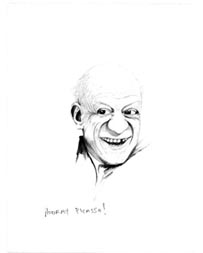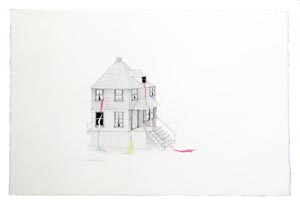
|
||
|
Portland art blog + news + exhibition reviews + galleries + contemporary northwest art
|
||
Ty Ennis at NAAU
Posted by Jessica Bromer on November 07, 2006 at 12:42 | Comments (10) Comments Oh, peeshaw. Sure, Ennis is on par with the herein mentioned Dzama (an easy reference point that's been made before), though the tongues speak in the topical (Dzama) and the existential (Ennis). Can't we look outside of this form of repeated reference? I mean, if you actually look close, yes, look (and I'm not pointing specifically at the writer of this review as she's formally and liguistically shown a critically hewn eye) - you may see similar lines in greats like Dürer and Degas. Take that breathy gander and you may start to see fanciful lines that are a bit deeper and sharper than a quick pass may collect. Personally, I felt 'The Bronze Loss' was a dynamic and intimate exhibition that doesn't try to grow the artist outside of his already lithe skin. Yes, he's young, the work is still somewhat young, it's fresh - and that's most likely why it is so intriguing. And that has nothing to do with age. Though it comes from dedication, the committment to the process, the studio ethic that Ennis has developed. His satire is wry and autobiographical. Of course it is, the man is still reasonably under 30 for goodness sake. He's significantly started to cut his teeth though, and kept the tone rather ambiguous through illustration and illusion. I love the way he doesn't merely blow smoke up our ass, instead, he tells tales of loss with a sensitive whisper as seen in the genuinely psychedelic/schizophrenic 'Georgie'. It's like 2 parts tie-dye, very 70s, and mix in the pixie dust of Storm Tharp and voila! It's possibly walking us through stages of a single man's life? It's melancholy is unnerving. In much the same way the barren forest in 'And cast into a well hidden well within my mind' bellows into the psyche followed by an echo of remorse. The beer cans and doggie heads are strongly drawn studies of a starry-eyed artist looking at his own personal still lives perhaps - purposefully pathetic and immediate. These drawings speak of the spaces artists - not always the just-so bright four walls of the art gallery or museum - but to the contrary, in the dusty and dank studio hovels that we rent in hopes of encouraging collectors and others. They speak of real physical space. What clouds our vision are often the simple things. Every mark in 'Four Wishes' seems to be a breath, drawing life in real time. Ennis has distilled a handful of cattails with basic reference and lots of the void, empty white space which only gives them a a bed to lilt upon poetically. The whole show has this wafting haiku, yet punctuated and strict like a musical composition. 'After we died, you were quick to haunt' is a curious piece that expertly floats a back end view of a female figure donning a 3/4 length sweater sweater, the kind you might buy at Goodwill. What makes it curious is, of course, the title. I'm STILL thinking about what it "says". Knowing the self-referential process Ennis undergoes, possibly she is a relative, or someone close to him with whom he shared a certain loss. Any way you slice it, her faceless half-turned gaze shapes an eerily shiny mane of rich black hair that organically undulates over the distinctive stripes of the sweater. And his tentative use of color references hand-colored silver gelatin prints, with just a hint of sepia. Over and above this is pretty much the best game in town at the moment. Posted by: TJ Norris Not to cheeze you Teej, I havn't seen this show yet so I can't weigh in on the show specifically but Ive never been much of a fan, but sometimes there are flashes in Ty's work I wouldn't deny. Locally, I like Carson Ellis and Joe Biel (http://www.gregkucera.com/biel.htm a former portlander) better. Both have always felt like they have more developed philosophies. Also, if the drawing is self conscious... then Dzama is a relevant talking point. Oh and I think Dzama is pretty existential... even compared with Sam Durant. Also, I think if we are reaching back before the 20th century Goya is possibly the father of all of these artists... and he still holds the title of course. Only Egon Schiele is in a position to challenge him. Luckilly, it's art and it isn't so much a competition as it is competitive. Posted by: Double J Hold the cheese, please. :) Posted by: TJ Norris PS: I own works by both Ennis and Biel and find them evenly exchangable after 100s of viewings. Saw a show of Dzama's up at Kucera's joint earlier this year and must say I have limited interest in the daunting coyness therein. Posted by: TJ Norris I liked Dzama 6 years ago, and still like his better work. Biel has a laser-like maturity even when adolescent, which is why he's getting some bigger-time national attention. Ennis has grown judging from the work I saw at your show, cant wait to check this out at NAAU. Overall I dont really see this as a referendum on "art on paper", although I do sense that schadenfreude as a philosphical base for self conscious dawings has really been wearing thin on art vewers. Posted by: Double J Ok, now Ive seen the show. Technically Ennis has matured but the philosphical underpinnings are often way too immature to for me to stand. Carson Ellis, Joe Biel and Storm Tharp are much farther along. Actually, Storm was in the gallery too and I gave him another round of good natured "I expect you to kick ass for your next show" expectations. We discussed the peculiarities of pressure to evolve and expand before a show and how that process gets judged once a show is up. In growth terms Ennis' show is a big step up from the previous one, he's just got a lot of room to grow from here. There are a 2-4 really nice ones in here though. Posted by: Double J My response to Ennis' work since the first time I saw it at Disjecta years ago, is a simple no. His subjects strike me as false, maudlin, and cliched. The most unappealing part and the part that destroys whatever might have been in the work is quickly noticing that his drawings are simply set-ups for the punchline that can be found in the title. Can anybody tell me what the punchline for Warhol's Soup Can is? How about Koon's Equilibrium Tank? Robert Longo's Men in Cities? Tracey Emin's Bed? Or any single Dzama drawing? Posted by: jerseyjoe Aligning Ty Ennis' work with that of Durer seems absurd. The draughtsmanship in Ennis' work has a long way to go to even approach Durer's achievements. Calling it "fresh" may have worked 10 years ago, but now the work seems to be extending stale, trite trends in drawing. As for the review, I found it to be very evenhanded and thoughtful. Posted by: harperschwartz "Absurd" is an "interesting" word. Posted by: TJ Norris The punchline issue is really perceptive... it reminds me of poetry slams where the poet who does best is usually the funniest one. Also it looks like the trial of Ty Ennis is underway. Many felt he was too green for the Biennial?... I'm not one of them but I believe he has a ways to go. Posted by: Double J Post a comment Thanks for signing in, . Now you can comment. (sign out)
(If you haven't left a comment here before, you may need to be approved by
the site owner before your comment will appear. Until then, it won't appear
on the entry. Thanks for waiting.)
|
| s p o n s o r s |
 |
 |
 |
 |
 |
 |
 |
 |
 |
 |
 |
 |
 |
 |

|
Site Design: Jennifer Armbrust | • | Site Development: Philippe Blanc & Katherine Bovee | |




![[TypeKey Profile Page]](http://www.portlandart.net/nav-commenters.gif)